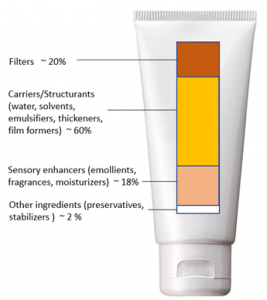In a recent article, we have discussed how the science of “watching paint dry” can help revolutionize personal care formulation.
Personal care product formulators can use structural ingredients to manage the escape speeds of elusive formulation components (Figure 1) while building up the required viscoelasticity for achieving uniform coverage on the skin (Figure 2).

Figure 1: The “drying” process of a cosmetic product.

Figure 2: Achieving uniform cosmetic coverage (right) on skin.
Let us now take a closer look at sunscreen formulation and how incorporating the ideal “paint-drying” engineering and technology can produce a much higher sun protection factor (SPF) without any additional filter usage. Optimizing and minimizing filter level provides many formulation benefits. Notably, it leaves more space in the formulation for sensory-enhancing ingredients that can encourage consumers to apply appropriate amounts of sunscreen more often. Regular application of sunscreen products is the most effective approach to combat the occurrence of skin cancers. Sunscreens capable of easily “drying” into a uniform layer on the skin consistently provide reliable sun protection for consumers. The typical composition of sunscreen is shown in Figure 3. Formulation ingredients usually fall into four categories:
- Filters are the active ingredients that prevent harmful sun irradiation from reaching the skin. These molecules are capable of absorbing or reflecting the unwanted irradiation. Their unique structures allow the absorption and reflection processes to happen efficiently and without significant consumption of the filter molecules. In other words, the ideal filter molecules intercept harmful sun irradiation without being chemically altered. This is possible because filter structures are designed to efficiently release the intercepted solar energy in the form of heat. Filters can make up about 20% or more of the sunscreen formulation.
- Carriers and structurants shape sunscreen into a form that is physically acceptable for use by consumers. Their primary function is to deliver the filter molecules correctly and smoothly onto skin. They play an essential role in providing uniform skin coverage during and after product application.
- Sensory and other functional enhancers provide the desired sensation to sunscreen. They are essential to favourable consumer perception of the product and also help structure the skin
- Other ingredients, such as preservatives and stabilizers, enable sunscreen to stay effective during its prescribed storage lifetime. Many brands also incorporate their specific marketing additives.

Figure 3: Common composition of a sunscreen product.
In Figure 4, we see the impact of coverage uniformity on sun protection performance via SPF numbers. The same amount of filters is used in all three cases; the amounts are represented using shaded rectangles. For illustrative purposes and to simplify the calculations, we assert that each rectangle contains an amount of filter molecules that allows 10% of the incoming irradiation energy be transmitted while the other 90% is intercepted.
The SPF number is, by definition, the ratio of the incoming irradiance over the transmitted irradiance. In all three cases, the same amount of incoming irradiance is applied over the same unit area. The only difference among the three cases is the uniformity of the sunscreen coverage. The case on the right assumes ideal uniform coverage, and a SPF of 100 is attained. The two cases on the left assume coverages that are not uniform, and their SPF numbers are much lower. The case with the least uniform coverage obtains the lowest SPF: 4.5.

Figure 4: SPF numbers resulting from use of the same amount of filter but different degrees of coverage uniformity.
The benefit of uniform coverage to sunscreen performance is therefore obvious. Now the challenge to the formulation community is how to achieve that uniform coverage. Based on learnings from the paint industry, advances in the following two directions are critical:
- Chemistry and physics to enable the right formulation rheology and produce appropriate viscoelasticity for the cosmetic film during the entire lifetime of the sunscreen on skin.
- Practical testing and validation methods for the uniformity of cosmetic film, both in silico and on human skin.
There are existing knowledge bases for both areas that personal care formulators can leverage from extensive research done in the coatings industry on the paint designing and drying processes.
However, there have been few studies in the personal care industry that investigate the molecular and engineering design required for uniform skin coverage. Those who commit resources to research fundamental knowledge and practical solutions will have the opportunity to be leading the industry forward.
Enjoyed this article? Get more by subscribing to our newsletter!
Feeling inspired to see ingredients and trends in action?
Then why not visit one of the in-cosmetics events around the world?

